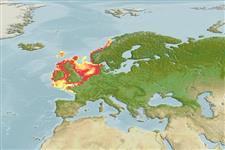Common names from other countries
Environment: milieu / climate zone / depth range / distribution range
Ecologia
marino; salmastro demersale; oceanodromo (Ref. 51243); distribuzione batimetrica 0 - 100 m (Ref. 35388), usually 10 - 20 m (Ref. 1371). Temperate; 68°N - 44°N, 11°W - 13°E
Northeast Atlantic: Trondheim on the Norwegian coast to the Bay of Biscay; also around the British Isles.
Size / Peso / Age
Maturity: Lm ? range ? - ? cm
Max length : 30.0 cm TL maschio/sesso non determinato; (Ref. 1371); common length : 20.0 cm TL maschio/sesso non determinato; (Ref. 4645)
Spine dorsali (totale) : 0; Spine anali: 0. Head depressed. First dorsal fin poorly developed, with only three short rays. Color uniformly dark brown or bluish brown; the lips and the distal areas of all fins paler except for the pectorals.
Lives in coastal waters at shallow depths, generally from 10-20 m, more seldom from 75-100 m, on rocky bottom with seaweeds. Solitary and secretive, undertakes only limited local movements. Spawns from May to September at 50-70 m depth near the shore throughout its entire range. Feeds on sea stars, crustaceans, worms, mollusks and small fish (Ref. 1371).
Life cycle and mating behavior
Maturities | Riproduzione | Spawnings | Egg(s) | Fecundities | Larve
Oviparous, sexes are separate (Ref. 205).
Cohen, D.M., T. Inada, T. Iwamoto and N. Scialabba, 1990. FAO species catalogue. Vol. 10. Gadiform fishes of the world (Order Gadiformes). An annotated and illustrated catalogue of cods, hakes, grenadiers and other gadiform fishes known to date. FAO Fish. Synop. 125(10). Rome: FAO. 442 p. (Ref. 1371)
IUCN Red List Status (Ref. 130435)
CITES (Ref. 128078)
Not Evaluated
Threat to humans
Harmless
Human uses
Pesca: di nessun interesse; Acquario: Acquari pubblici
Strumenti
Special reports
Download XML
Fonti Internet
Estimates based on models
Preferred temperature (Ref.
115969): 8.5 - 12.5, mean 10.4 (based on 120 cells).
Phylogenetic diversity index (Ref.
82804): PD
50 = 1.0000 [Uniqueness, from 0.5 = low to 2.0 = high].
Bayesian length-weight: a=0.01072 (0.00412 - 0.02789), b=3.06 (2.83 - 3.29), in cm Total Length, based on LWR estimates for this (Sub)family-body shape (Ref.
93245).
Trophic level (Ref.
69278): 3.8 ±0.56 se; based on food items.
Fishing Vulnerability (Ref.
59153): Low vulnerability (20 of 100).
